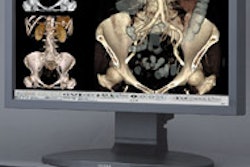An application service provider (ASP)-based PACS network can yield substantial cost savings compared with a traditional capital purchase model (CP-PACS), driven largely by the opportunity to purchase inexpensive display components directly from suppliers, according to research from the University of Texas M. D. Anderson Cancer Center (MDACC) in Houston.
"In a large academic radiology practice, ASP-PACS has a favorable business model compared with (CP-PACS)," said Dr. Kevin McEnery, who presented the findings at the 2004 RSNA meeting in Chicago.
MDACC abandoned a capital-purchase-based PACS implementation in favor of an ASP-PACS model in 2000. At the time, luminary institutions running filmless operations typically employed high-resolution analog monitors in two- or four-monitor configurations for diagnostic reading, with a two-monitor, medium-resolution design for clinical image review in the clinics, McEnery said.
The four-monitor workstations cost $167,000, while a two-monitor setup was priced at $100,000. The clinical workstation came in at $60,000.
At the end of 2000, the institution was in the midst of a PACS rollout, including installing three workstations in the diagnostic imaging department; workstations were also deployed in two trial clinics. A one-year optical disk archive was put in place as part of a short-term/long-term archive paradigm.
Enterprise image distribution was handled via an ASP provider, which MDACC then switched to for the full PACS network when the vendor added that technology to its product line.
The research team sought to compare the actual and anticipated costs of an ASP-PACS with the planned budget of a partially implemented CP-PACS between 2001-2006. ASP case volumes were based on actual data from 2001-2003 and estimated figures from 2004-2006.
The ASP-PACS project involved deploying 80 workstations in diagnostic imaging at an average cost of $25,000 per workstation. Three workstations were installed outside of the diagnostic imaging department -- two in the ICU and one in the ER.
No other workstations were deployed in the hospital and clinics, as the LCD monitors used there were judged to be sufficient, McEnery said.
"This avoided the purchase of an estimated 140 workstations at $60,000 per workstation," he said.
In planning for the initial CP-PACS system, MDACC had anticipated a need for 33 workstations, but 80 were required due to an unanticipated increase in case volume and the number of radiologists reading the studies, McEnery said.
For cost comparison purposes, the researchers assumed that those extra workstations would have had to be purchased under the CP-PACS model, even though they were not budgeted initially. The study team also assumed that the personnel costs were the same for both systems, that the actual FTEs needed for ASP-PACS were the same as initially planned for CP-PACS, and that network implementation infrastructure requirements were the same for both approaches.
The six-year costs for ASP-PACS reached $13.6 million, consisting of approximately $2 million in workstation capital and service costs, and $11.6 million in operational costs for 1.54 million imaging studies. CP-PACS would have generated approximately $32.2 million in costs, including $21.6 million in workstation capital and service costs, and $10.6 million in image archive capital and service costs, McEnery said.
As a result, ASP-PACS produced total savings of $18.6 million, produced by $19.6 million in savings from the reduced costs and operation of workstations from ASP-PACS, McEnery said. MDACC attributed the savings largely to the ability to purchase less expensive workstation components directly from OEM providers.
Of course, PACS economics have changed dramatically over the past five years, impacted by the lower cost of technology such as monitors and CPUs, he said. In addition, the advent of ASP-based pricing approaches has impacted the margins of traditional capital-purchase vendors, he said.
"Traditional capital-purchased PACS has clearly changed its structure to protect market share," McEnery said.
Radiologist workstations in 2002 ran about $30,000, and they can now be had for under $18,000, he said.
McEnery noted that the CP-PACS analysis does not account for necessary upgrade costs that would have been necessary had the analog monitors been purchased in 2001. He also acknowledged that the price of workstations under a CP-PACS model have significantly decreased since 2001, but the cost analysis accounts for what the institution would have had to spend at the time of anticipated purchase.
"Even today, though, capital-purchased PACS workstation costs are still substantially greater than OEM component costs that we now experience," he said.
The list price cost-per-exam for the ASP-based PACS approach MDACC uses is $7.50, although the institution pays less, McEnery said.
By Erik L. Ridley
AuntMinnie.com staff writers
December 17, 2004
Related Reading
Patient identification aided by picture wristbands, December 2, 2004
PACS yields quantifiable savings for large academic sites, December 2, 2004
Telerad services solve problems, generate revenue, December 1, 2004
PACS plus paperless proves powerful, November 29, 2004
Copyright © 2004 AuntMinnie.com



















